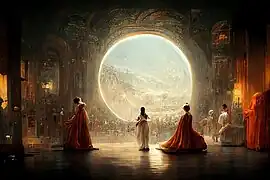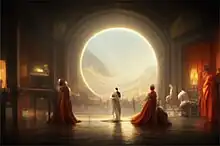| Théâtre D'opéra Spatial | |
|---|---|
 | |
| Artist | Midjourney, using a prompt by Jason M. Allen |
| Year | 2022 |
| Medium | AI art |
Théâtre D'opéra Spatial (French for "Space Opera Theater") is an image created by the generative artificial intelligence platform Midjourney, using a prompt by Jason Michael Allen. The image became a news story when it won the 2022 Colorado State Fair's annual fine art competition on September 5, becoming one of the first AI generated images to win such a prize.[1][2]
Reactions
Théâtre D'opéra Spatial winning the Colorado State Fair's contest for "digital arts/digitally-manipulated photography" led to a backlash from artists who accused the winner, Jason Michael Allen, of cheating.[3] Allen responded: "I'm not going to apologize for it. I won, and I didn't break any rules."[2]
The two category judges were unaware that Midjourney, which Allen disclosed usage of in his submission, utilized artificial intelligence (AI) to generate images, although they later said that had they known this, they still would have awarded Allen the top prize anyway.[2]
The image, created using a text prompt, was upscaled using Gigapixel AI.[4]
Copyright
In September 2023, the United States Copyright Office review board found[5] that Théâtre D'Opéra Spatial was not eligible for copyright protection as the rules "exclude works produced by non-humans".[6] This decision reaffirms previous guidance given in respect of AI by the Office[7] and a recent court case, Thaler v Comptroller-General of Patents, Designs and Trademarks[8] which found against Thaler on the basis of a principle of human authorship that, though not enshrined in copyright law, is a working principle used by the Office.

Allen insists he will continue to try to gain copyright registration:
Allen was dogged in his attempt to register his work. He sent a written explanation to the Copyright Office detailing how much he'd done to manipulate what Midjourney conjured, as well as how much he fiddled with the raw image, using Adobe Photoshop to fix flaws and Gigapixel AI to increase the size and resolution. He specified that creating the painting had required at least 624 text prompts and input revisions.[9]
Some legal writers support his claim[10] and consider it to be form of technological discrimination comparing it with the treatment of photographs and the modern use of electronic cameras.
See also
References
- ↑ "Explained: The controversy surrounding the AI-generated artwork that won US competition". Firstpost. 2022-09-05. Retrieved 2023-03-26.
- 1 2 3 Roose, Kevin (2022-09-02). "An A.I.-Generated Picture Won an Art Prize. Artists Aren't Happy". The New York Times. ISSN 0362-4331. Retrieved 2023-03-26.
- ↑ Metz, Rachel (2022-09-03). "AI won an art contest, and artists are furious | CNN Business". CNN. Retrieved 2023-03-26.
- ↑ Gault, Matthew (31 August 2022). "An AI-Generated Artwork Won First Place at a State Fair Fine Arts Competition, and Artists Are Pissed". Vice. Retrieved 2023-04-03.
- ↑ Second Request for Reconsideration for Refusal to Register Théâtre D'opéra Spatial (SR # 1-11743923581; Correspondence ID: 1-5T5320R)
- ↑ Helmore, Edward (24 September 2023). "An old master? No, it's an image AI just knocked up … and it can't be copyrighted". The Guardian.
- ↑ Copyright Registration Guidance: Works Containing Material Generated by Artificial Intelligence, March 16, 2023
- ↑ Thaler v Comptroller-General of Patents, Designs and Trademarks,
- ↑ Knibbs, Kate (2023-09-06). "Why This Award-Winning Piece of AI Art Can't Be Copyrighted". Wired. ISSN 1059-1028. Retrieved 2023-10-08.
- ↑ Pink-Howitt, Peter (2023-10-04). "Copyright, AI and Generative Art". Ramparts. Retrieved 2023-10-08.

